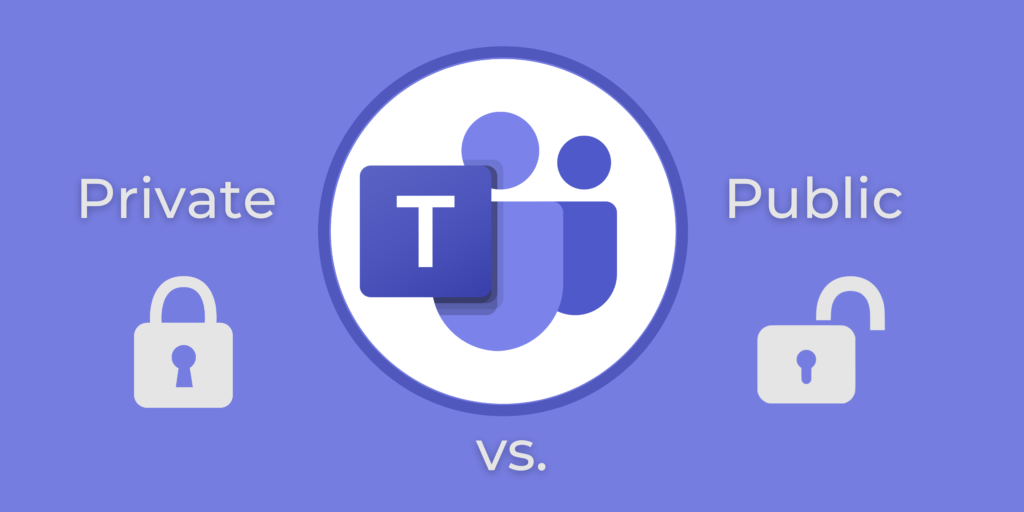Whenever we create a new team in Microsoft Teams, we’re always given a choice whether to keep the team private or make it public. This will determine how your users will use the team, and what information can and should be shared there.
If you’re constantly facing this dilemma, this blog post is for you! We will explain the key differences between public and private teams, help guide in understanding which ones suit best for your needs and how to enforce team privacy settings.
Types of Microsoft Teams privacy settings
When creating a new team, you can choose to configure one of the following team privacy settings:
- Private
- Public
- Org-wide
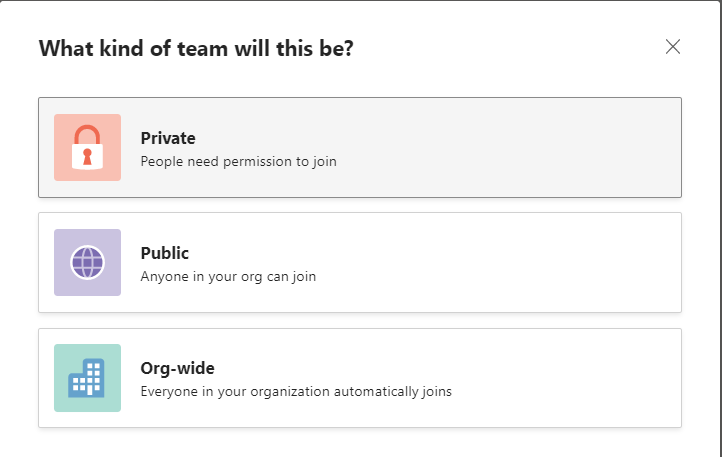
Private teams are only accessible to the team members added by the team owner.
Public teams are visible to the whole organization and any user can join them without getting approval from the team owner firs.
Org-wide teams pretty much speak for themselves: every user in the organization will automatically be added as a member as soon as an org-wide team is created.
Now, let’s dive a little deeper into each type of teams and understand when to choose each.
Private teams
In most cases, organizations opt for creating private teams. This is a default experience in Teams, for most of the time the information exchange applies to the team only.
All the information shared in a private team such as files and conversations is accessible to only to the members and owners of that team. However, they can share files with other users outside the team.
Only team owners can add other users as members. Team members may invite other users to join, but the request must be approved by the team owner first.
When to create a private team?
You will probably need to create private teams most of the time, especially if we talk about large organizations. Whenever there’s sharing of sensitive information involved, you may want to make sure it’s accessible only to a limited number of users.
Whenever you need to collaborate with external stakeholders such as partners, customers, and others, it is much more reliable to work in a private team from a security standpoint.
When you need to work on a specific project, account, campaign, or other activity that implies involvement only of specific people, private teams are the way to go.
Finally, you may not want people from a different business unit to join your team as it can create confusion in conversations. So, when it comes to teams representing your organizational structure, you may want to add only relevant users.
Public teams
Public teams are visible to everyone in the organization, and anyone can join them. Team members can invite other users, including guest users, to join without the need of an approval from the team owner.
When a user joins a public team, they automatically receive access to all the content of the team such as channel conversations, files and folders, and apps.
When to create a public team?
This will depend a lot on your organization’s culture. You may opt for a public team whenever the purpose of the team doesn’t imply sharing sensitive data. That can be expertise-sharing teams or teams around specific topics that may interest certain groups of people within your organization.
You can also create public team for organizing internal events and activities.
Org-wide teams
As understood from the name itself, org-wide teams include all the people in the organization. Everyone is added automatically as soon as the team is created.
However, there are certain limitations to org-wide teams.
• Only Global Admins can create them or change the team privacy setting to or-wide.
• The limit for an org-wide team is 10,000 users, so larger organization cannot opt for this type of teams.
• There can be a maximum of 5 org-wide teams per organization.
When to create an org-wide team?
You can create an org-wide team for internal communication. Let your employees know about upcoming events, organizational news, achievements, and various activities. You may also want to use this team to recognize individual or group contribution and praise your employees.
However, if your organization has over 10,000 employees, you can create a Yammer community for the same purpose and add it as a tab to relevant teams. Learn more about how to use Teams with Yammer here.
You may also want to create an org-wide team for communicating about important internal project. For example, when an organization is undergoing an organizational transformation and needs to keep everyone up to date about its course.
How to change team privacy status
If you realized you chose wrong team privacy settings or you just decided to change your teams’ status from public to private, or vice versa, there’s a simple way to do it.
In Teams tab on the left navigation bar find the team you need and click on More options […] > Edit team.
Choose the right privacy configuration and click on Done.
You’re all set now!
Note that in order to change team’s privacy to org-wide, you need to be a Global Admin.
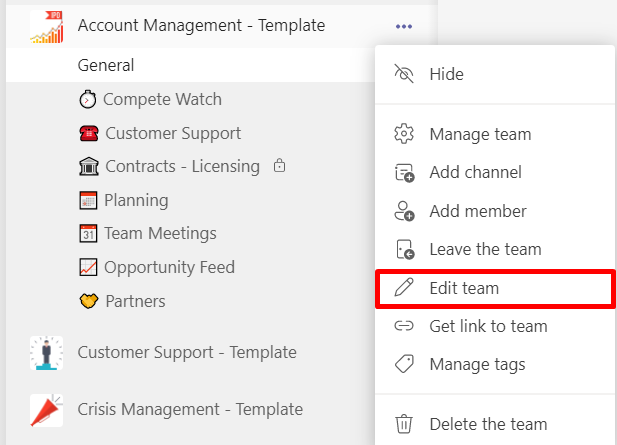
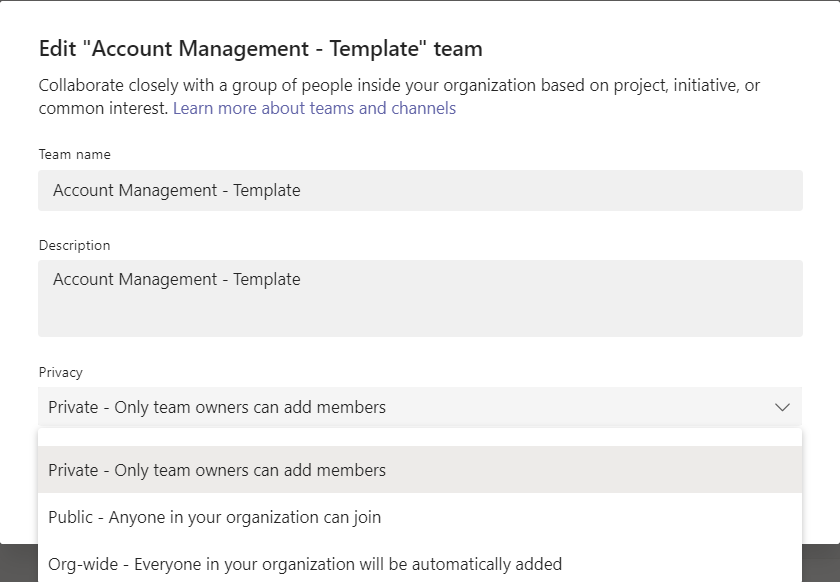
Enforce team privacy settings at the template level
Natively, in Microsoft Teams any team owners can make teams private or public and change these configurations after the team is already created.
Now, let’s imagine you have a private team around a certain project that your organization is undertaking. Your project team use it to discuss and collaborate on every element of the project, including highly sensitive matters that shouldn’t leave this team.
If any of the team owners for whatever reason changes the team privacy settings from ‘Private’ to ‘Public’, anyone in the organization will be able to see and join it. This means that all the conversations, files and other content shared in the team will be accessible to anyone in the company.
However, there is a way around it. You can enforce team privacy settings at the template level.
Coming back to our project team example, you may want to create a Teams template that your employees will use to create teams for this very purpose. For example, you can create a Project Management template. So, whenever a new project comes up, you will have a template ready at place with all the right content and pre-configurations to create new teams.
When you configure governance policies, select the privacy settings you want to enforce for the teams created from this template.
Enforced privacy settings make sure team owners won’t be able to change them.
Learn more about Microsoft Teams security best practices.
How to do it?
Step 1. Create an original team that you will use for the template
Step 2. Add channels, files, folders, tabs and all the required content.
Step 3. Open the SalesTim app in your Teams environment.
Step 4. Go to Catalog > +New template
Step 5. Select the original team you just created
Step 6. Configure governance policies, including security settings.
Step 7. Click Save.
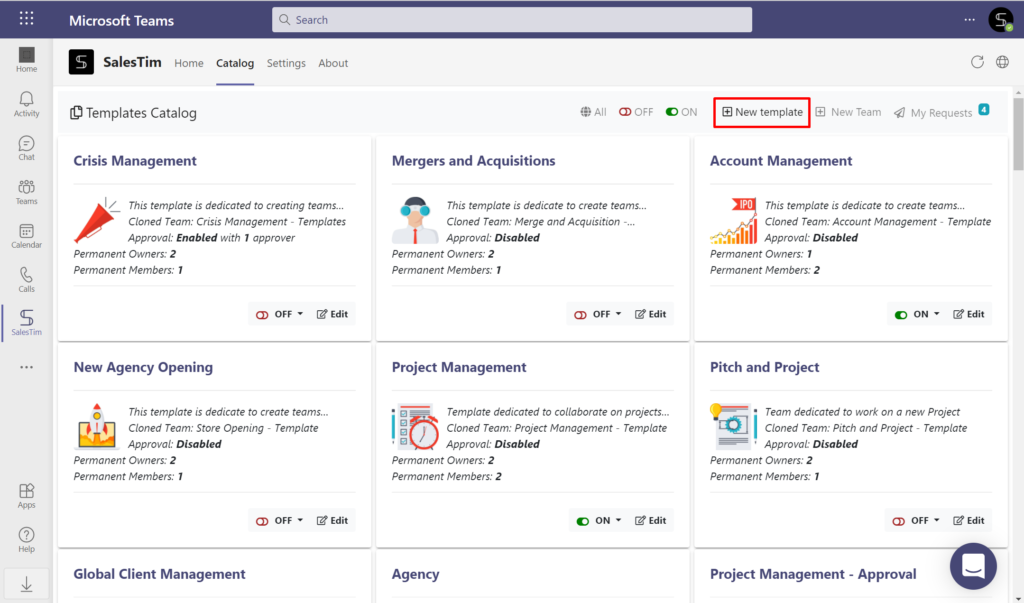
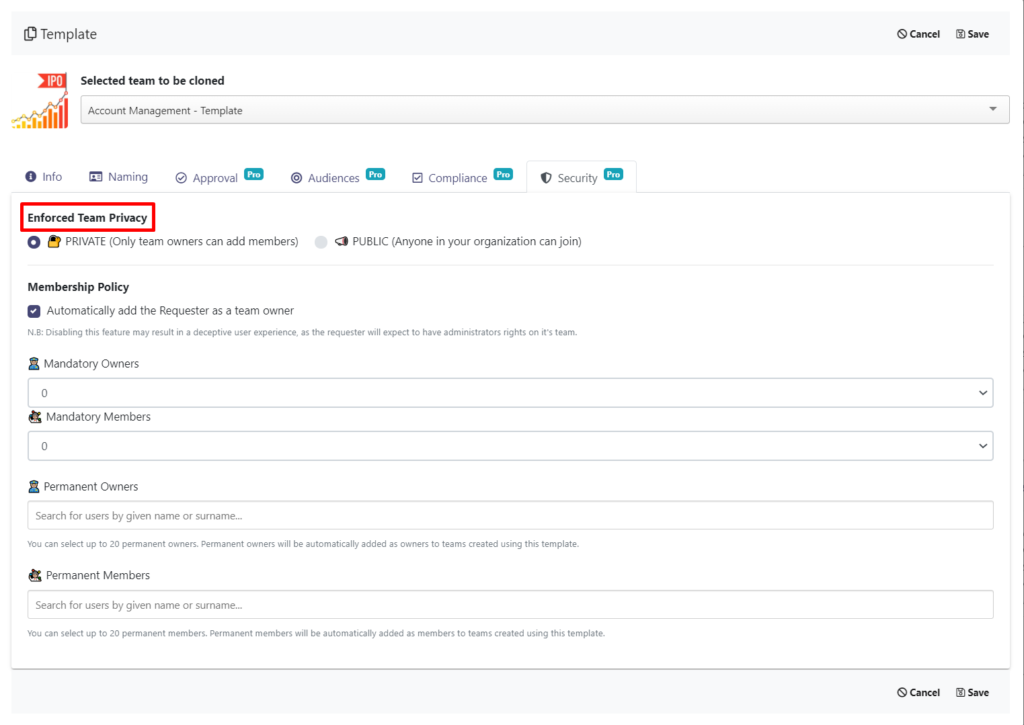
Now, when your users need to create a new team around this topic, they will only need to select this template. All the content included in it as well as configurations will be automatically cloned to the new team.
Contact our team to learn more about Collaboration template governance policies and how you can leverage them for your organizational needs.
